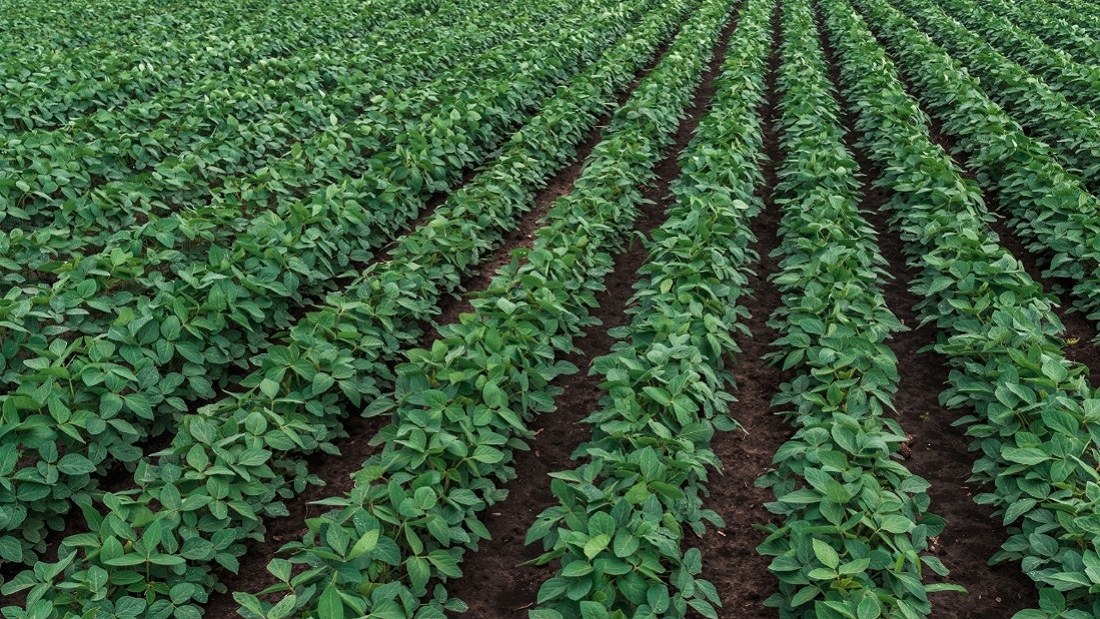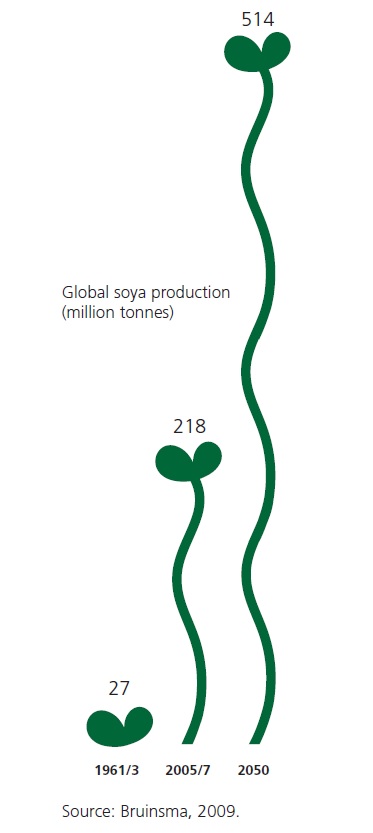Soya

Believe it or not, meat-eaters actually consume more soya than vegans! It’s true – albeit indirectly – because three-quarters of the world’s soya is used for animal feed. Feeding a highly nutritious plant food to animals, in order to produce meat and dairy foods is inefficient and wasteful. Used to fuel the increasing global demand for meat and animal-based foods, soya has now become one of the world’s biggest crops. Much of the deforestation occurring in the world today, and the loss of biodiversity that goes with it, is to make way for soya – to feed farmed animals. The wide-scale adoption of a vegan diet could stop this relentless expansion.
Pulses or legumes (peas, beans, lentils and soya beans), have been cultivated for thousands of years and play an important role in the diets of many people around the world. It’s impossible to imagine the traditional foods of India, South America, Mexico, the Middle East or Asia without lentils, black beans, pinto beans, chickpeas and soya beans.1Messina MJ. 1999. Legumes and soybeans: overview of their nutritional profiles and health effects. American Journal of Clinical Nutrition. 70 (3 Suppl) 439S-450S.
Traditional foods made with soya beans include soya milk and tofu. Fermented soya foods include soya sauce, nattō and tempeh. More recently, soya has been used widely to make meat substitutes such a textured vegetable protein (TVP), soya burgers, sausages and mince.
Soya beans are valued for their high protein and fat content, about 40% and 20% respectively.2Reinwald S, Akabas SR and Weaver CM. 2010. Whole versus the piecemeal approach to evaluating soy. Journal of Nutrition. 140 (12) 2335S-2343S. The fat content is so high that the Food and Agriculture Organisation (FAO) of the United Nations class soya as an oilseed, whereas in the US it is classed as a grain. Soya produces more protein per hectare than any other major crop and has a higher percentage of protein than many animal-based foods. It can feed more people per acre than almost any other plant, which makes it a highly desirable crop – but not just for people. Around 70-75% of the world’s soya ends up as animal feed for cows, pigs, chickens and farmed fish.3Brack D, Glover A and Wellesley L. 2016. Agricultural Commodity Supply Chains: Trade, Consumption and Deforestation. Chatham House Research Paper. https://www.chathamhouse.org/sites/default/files/publications/research/2016-01-28-agricultural-commodities-brack-glover-wellesley.pdf
A typical soya bean is much more likely to end up in a ham-and-cheese sandwich or a chicken nugget than a block of tofu according to the Union of Concerned Scientists, a national non-profit organisation made up of nearly 250 experts dedicated to creating solutions for a healthy, safe and sustainable future. They say that only about 6% of soya beans grown worldwide are turned directly into food products for humans. The rest are used for animal feed or are used to make vegetable oil or non-food products such as biodiesel.4UCSUSA. 2015. Soybeans. https://www.ucsusa.org/resources/soybeans
The growth of soya

Soya has come a long way since it originated in China around three thousand years BC. It was introduced to Europe and North America in the 18th century, but wasn’t grown on a significant scale outside Asia until relatively recently. Large-scale production took off in the US after World War II, and by 1970, the US was producing three-quarters of the global crop. When the US began running out of suitable land for expansion, soya began its long march into South America.1WWF. 2014. The Growth of Soy, Impacts and Solutions. http://awsassets.panda.org/downloads/wwf_soy_report_final_feb_4_2014_1.pdf
Since the 1950s, global soya production has increased 15 times over, according to the World Wide Fund for Nature (WWF). The US, Brazil and Argentina together now produce about 80% of the world’s soya.
The growth in soya production in developing countries has been explosive, especially in Brazil and Argentina. Scientists estimate that by 2050, the world’s developing countries will be contributing 70 per cent of the global production of soya, with just four countries (Brazil, Argentina, China and India) accounting for 90 per cent of production.2Bruinsma, J. 2009. The resource outlook to 2050: by how much do land, water and crop yields need to increase by 2050? Paper presented at the FAO Expert Meeting, 24-26 June 2009 Rome on “How to Feed the World in 2050”. http://www.fao.org/3/a-ak971e.pdf
Soya now covers over one million square kilometres (386,100 square miles) of land, equivalent to the total combined area of France, Germany, Belgium and the Netherlands.1WWF. 2014. The Growth of Soy, Impacts and Solutions. http://awsassets.panda.org/downloads/wwf_soy_report_final_feb_4_2014_1.pdf Growing demand from the EU, and more recently China, has been the main driver behind the expansion of soya. Sadly, the popularity of this humble bean has nothing to do with its original use in tofu, miso, soya milk or soya sauce. The desire, from both industrialised and industrialising countries, is driven by its use as animal feed.
In 1995, China was self-sufficient in soya beans, producing five million tons a year. However, rising living standards have led to many people adopting a more Western-style diet. The increasing demand for soya for animal feed in China has been driven by this explosion in the demand for meat, as consumers switch from a diet dominated by rice, to one where pork, poultry and beef play an increasingly important part.
For over 3,000 years soya products formed an essential part of Chinese people’s diet and even when its population reached more than a billion, it was still self-sufficient in soya. It was only when they turned to the mass consumption of meat and dairy that China’s demand for soya exceeded their ability to grow it.
Taking a highly nutritious plant food and feeding it to animals in order to produce meat, fish, eggs and dairy foods for people is inefficient and wasteful. Compared to soya protein production, meat production requires 6-17 times more land, 4.4-26 times more water and 6-20 times more fossil fuels.3Reijnders, L. and Soret S. 2003. Quantification of the environmental impact of different dietary protein choices. American Journal of Clinical Nutrition. 78 (3), 664S-668S.
Overwhelmingly, the main importer of soya is China, taking 43% of all soya imports in 2014, mainly for animal feed for its growing meat industry.4Brack D, Glover A and Wellesley L. 2016. Agricultural Commodity Supply Chains: Trade, Consumption and Deforestation. Chatham House Research Paper. https://www.chathamhouse.org/sites/default/files/publications/research/2016-01-28-agricultural-commodities-brack-glover-wellesley.pdf By 2017, China was producing 13.8 million tons a year but importing much more; the USDA expected that China would import over 90 million tons in the 2016-2017 marketing year. To put this massive demand into perspective, China now accounts for nearly two-thirds of the world’s soya imports5Braun K. 2016. China imports will keep U.S. soybean market on its toes. https://www.reuters.com/article/us-china-soybeans-braun-idUSKCN11F2GT and is expected to significantly increase its imports as demand for animal-based foods increases.6WWF. 2020. Soy, overview. https://www.worldwildlife.org/industries/soy
The EU is the second largest importer, using soya for animal feed and biofuel.4Brack D, Glover A and Wellesley L. 2016. Agricultural Commodity Supply Chains: Trade, Consumption and Deforestation. Chatham House Research Paper. https://www.chathamhouse.org/sites/default/files/publications/research/2016-01-28-agricultural-commodities-brack-glover-wellesley.pdf The EU imports the equivalent of 60 kilograms of soya per year for every adult and child living in the EU – that’s almost 40 million tons – the vast majority of imports come from outside the EU, where genetically modified soya is commonplace and is considerably cheaper to use in animal feed.7Agricultural Biotechnology Council. 2015. Going against the grain. https://www.nfuonline.com/going-against-the-grain-report/
The environmental costs
So what is the environmental cost of this massive soya expansion? Soya, according to the WWF, is the second largest agricultural driver of deforestation worldwide, after beef. From the Northern Great Plains of the US, to the Amazon of Brazil; forests, grasslands and wetlands are being ploughed up to make room for more soya production. When these native habitats are lost, it leaves wildlife without homes, accelerates climate change, leads to more water pollution, disrupts natural rain patterns and increases drought.1WWF. 2016. The story of soy. https://www.worldwildlife.org/stories/the-story-of-soy
This level of destruction is an environmental disaster, and loss of forests is a major contributor to greenhouse gas emissions, global warming and loss of biodiversity. The situation is getting worse as the world’s insatiable hunger for meat continues to increase.
In 2006, the FAO said that around 70% of previously forested land in the Amazon was now used for grazing, with animal feed crops covering a large part of the remainder.2FAO. 2006. Livestock’s Long Shadow. www.fao.org/docrep/010/a0701e/a0701e00.HTM In 2020, they said deforestation and forest degradation continue to take place at an alarming rate with a loss of 10 million hectares per year from 2015 to 2020. Large-scale commercial agriculture – primarily cattle ranching and cultivation of soya bean and oil palm – accounted for 40 per cent of tropical deforestation between 2000 and 2010.3FAO and UNEP. 2020. The State of the World’s Forests 2020. Forests, biodiversity and people. Rome. http://www.fao.org/state-of-forests/2020/en/
We are allowing forests to be cut down to make way for soya crop expansion, so that people can eat more animal-based foods – it makes no sense. The inefficiency of feeding plant foods to animals for meat has resulted in livestock dominating an astonishing 75% of the world’s agricultural land, either for grazing or growing animal feed.4Foley JA, Ramankutty N, Brauman KA, et al. 2011. Solutions for a cultivated planet. Nature. 478 (7369) 337-342.
Soya beans themselves are no more environmentally damaging to grow than any other bean; in fact they are less so, due to their superior nutritional composition. The fact that soya bean cultivation is causing environmental havoc across the globe is often used as a criticism of veganism, but it is meat-eating that is driving soya demand.
Much of the soya foods consumed directly by humans in the UK, are made with organic beans sourced from Europe and the US – unlike the genetically modified soya grown for animal feed. Plant-based milk manufacturers Alpro do not source soya from the Amazon. In their 2018 Sustainability report they say that in 2017, 60% of the soya beans they used were grown in Europe (100% of their organic soya beans were EU-sourced), with the rest coming from Canada.5Alpro. 2018. Sustainability summary. https://www.alpro.com/uk/news/sustainability-summary/
If you want to see less soya expansion, less deforestation, less biodiversity loss and less global warming, eat more soya! The decision to change to a vegan diet is better, not just for the animals and the rainforest, but also for all the other environmental catastrophes that are linked to livestock production; including the climate crisis.




